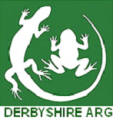About us
About Us
Welcome to Derbyshire Amphibian and Reptile Group we cover the whole of Derbyshire including part of the Peak District National Park.
Our group aims to promote the study and conservation of the amphibians and reptiles of Derbyshire and their habitats. We achieve this by:
- raising awareness of the ecology and conservation needs of Derbyshire's amphibians and reptiles
- undertaking practical conservation projects
- running approximately 20 Toads on Road patrols at locations across the county every spring during the toad migration season
- carrying out regular reptile surveys and amphibian surveys
- organising amphibian and reptile training sessions for members and the public
- providing advice and information and answering queries for the public
- developing recording, monitoring and research intitatives
- providing a forum for those interested in amphibians and reptiles
- working in partnership with other relevant organisations
We hope our website will help you to find the information you are looking for, but if you still have a query, please contact us and we will do our best to help.
Derbyshire ARG always welcome new members to the group, please email us on derbyshirearg@gmail.com to join. There is a membership subscription of £5 per year, though that is reviewed at every AGM..
We are very grateful for any records of amphibians and reptiles in your local area that you can pass to us as it helps in mapping the distribution of species and protecting their known habitats. Either contact us directly or use the Record a sighting tab on this website.
The group is run by a committee which is elected at the AGM each year. For 2024 - 2025 the committee elected at the AGM on 13th January 2024 are:
Chair - Kelvin Lawrence, Vice Chair - Christian Murray-Leslie, Secretary - Chris Monk, Treasurer - Jayne Thompson
Committee members - Garry Dorrell, Richard Fenn Griffin, Chris Hallam, James Longley, Sheila Stubbs and Ben Wyke
Kelvin Lawrence is also the Derbyshire Toad Crossings Co-ordinator for the Group & for Froglife
See a previous newsletters here
![]() January_2021_DARG_newsletter_31.pdf
January_2021_DARG_newsletter_31.pdf
![]() August_2020_DerbyshireARG_newsletter.pdf
August_2020_DerbyshireARG_newsletter.pdf
![]() February_2020_DARG_Events_newsletter.pdf
February_2020_DARG_Events_newsletter.pdf
![]() DARG_April_2019_newsletter.pdf
DARG_April_2019_newsletter.pdf
![]() DARG_January_2019_newsletter.pdf
DARG_January_2019_newsletter.pdf
Derbyshire ARG data policy
![]() DARG_data_protection_policy_November_2018.pdf
DARG_data_protection_policy_November_2018.pdf
News
News
Rewilding success at British Mountaineering Council owned Horseshoe Quarry
After Derbyshire ARG did surveys this year at Horseshoe Quarry the BMC have published the attached article https://www.thebmc.co.uk/rewilding-success-horseshoe-quarry-2024
Horseshoe Quarry, also known as Furness Quarry, is a large, disused limestone quarry in Stoney Middleton, Peak District with a long history of climbing and owned by the BMC since 2005. Almost three decades on, rewilding at the site has already been fantastically successful, with hundreds of newts and toad tadpoles spotted in the pond this spring.
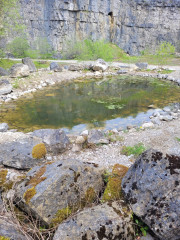 Horseshoe Quarry pond (left) Toad tadpoles just hatched in 2024 (right)
Horseshoe Quarry pond (left) Toad tadpoles just hatched in 2024 (right) 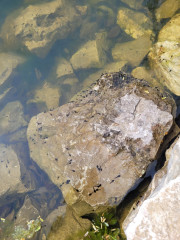
A short history of Horseshoe Quarry
Although climbers snuck in anyway, there was originally no CROW access to Horseshoe Quarry. So, in 2005 the BMC purchased an 8.5ha area of the site to secure access to walkers, climbers and cavers in perpetuity. Alongside this, a local management group was created to care for the area and promote local botanical and ecological interests, because the land lies within a Site of Special Scientific Interest (SSSI).
Over the years there has been a great deal of rewilding work at Horseshoe Quarry including footpath improvement, the creation of a wildlife pond, ecological surveys, woodland management and control of invasive species. So much so that this former quarry has become a highly reputable recreational and environmental asset.
In 2007 the Vision Project funded the creation of a wildlife pond to the south of the quarry floor, which is now teaming with wildlife, as Chris Monk, secretary of the Derbyshire Amphibian and Reptile Group (ARG) discovered this spring.
Rewilding: latest update
Chris Monk, secretary of the Derbyshire Amphibian and Reptile Group shares the good news.
What were the amphibian and reptile counts like before this restoration work?
Initially there was no pond in the quarry but a small area of shallow water that collected on the quarry floor and was used by amphibians. However these pools dried up in summer most years so the amphibian tadpoles would die. I was asked By the Peak District National Park Authority (PDNPA) staff in May 2006 to survey the quarry and other ponds in the area for their Vision Project. This revealed just over 30 smooth newts, some frogspawn and toad spawn strings in the shallow pools.
How has the site improved for amphibians and reptiles?
The PDNPA asked Henry Folkard [award-winning BMC Peak District volunteer and tireless access campaigner] whether they could include the quarry in their new Proliferating Ponds in the Peak funding bid to have a completely new pond constructed. The funding bid was successful and work to build the pond started in spring 2007. It was built close to the pools on the quarry floor so that the amphibians could easily find it and a survey in 2008 found smooth newts in the new pond with none in the shallow pools.
Over the years the amphibian population based around the pond has grown as there is now no risk of summer desiccation of the tadpoles. Also the pond has been colonised by great crested newts, so the pond is now used by all four amphibian species that are found across the White Peak.
What will you do with the survey information you collected?
The survey results are passed to the BMC and PDNPA, so that such a good amphibian population, especially with the presence of the legally protected great crested newt, is on record and is taken into account when considering management of the site.
How can BMC members and climbers using Horseshoe Quarry help maintain this improvement in wildlife?
By taking care when at the site to not disturb the boulders and rock piles in the old quarry as that could result in hiding amphibians being crushed or buried. Also by not introducing any plants or animals into the pond. Thank you.
Anything else to mention?
Little is known about reptiles in the area - a single grass snake was seen in the quarry in 2009 by Henry Folkard, but they range quite widely so it was probably just assessing the location. Slow-worms and common lizards could be present in or near the quarry but they are often difficult to spot. If anyone sees a reptile then please report it to the BMC and the PDNPA ecologists.
The initial pond work was funded by Derbyshire Aggregates Levy Grant Scheme (DALGS), which also funded the woodland walkway and link to the PROW down the Dale to the east. The recent pond renovation was funded via FiPL (Farming in Protected Landscapes).
The May 2024 survey of the pond by the Derbyshire Amphibian & Reptile Group counted 241 smooth newts, 14 great crested newts and thousands of toad tadpoles. The disused quarry is obviously an ideal location for amphibians with a good pond for breeding and excellent terrestrial habitat with its loose rock piles providing a mass of resting and hibernating locations for them.
2023 Surveys and Events
The Group's outdoor programme has now finished for this year, though we are attending one more indoor event in November and hope to set up an indoor members meeting & AGM in January or February..
The pond surveys carried out in the Peak District in the north of the county and in the National Forest in the south of the county were sucessful in involving a large number of members. They resulted in updated and new records of all 5 species of amphibians native to the county (common frog, common toad, smooth newt, palmate newt and great crested newt).The findings were reported to the landowners, Peak District National Park Authority, farmers and detailed site survey reports were done for the Derbyshire Wildlife Trust, the National Forest Company, the Woodland Trust and the Rosliston Forestry Centre (run by South Derbyshire District Council and Forestry England).
Members and local residents/volunteers participated in the toad crossing patrols at many sites across the county and adder emergence surveys were carried out in the Peak District as happens every year.
Reptile surveys were carried out at our two cover object survey sites at Hassop and at Linacre with sightings of common lizard, slow-worm and grass snake. Initially this year looked as though it would continue the run of cancellations due to bad weather for the Stanage visual surveys at North Lees after a run of 5 cancellations starting last year and again this spring & early summer. Eventually in August & early September we had better luck and actually managed to get out, survey and find lots of common lizards, including the first records from one of the moorland sites. We hope to get SSSI permissions for installing some cover object arrays next year in areas away from public pressure in the hope of finding some of the elusive snakes reported up there and for evidence of slow-worms. Meetings and advice were given to the National Trust about surveys and habitat works that could be undertaken on one of their sites that has an important grass snake population.
Our stall and display were taken to two public events this year, we were invited to the Friends of Pleasley Pit's Wildlife Day at the Pleasley Pit Country Park in May and in mid September we again attended the annual Derbyshire Woodland Festival at Elvaston Castle Country Park, The latter managed to avoid the rain, which turned up just after it closed on the second day and we spoke to numerous people about our native reptiles and amphibians and took many records of casual sightings people had made in their garden or out in the countryside.
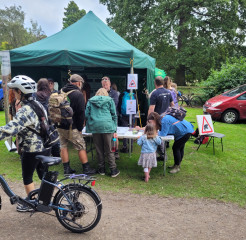
Our stand at the Woodland Festival
Nature and Species Recovery in Derbyshire
Derbyshire ARG was invited to a couple of meetings in January & February dealing with those issues
Firstly there was a seminar organised by Natural England to seek information on possible species recovery or re-introduction in the county for their upcoming grant scheme for projects.
Unfortunately there are no amphibian or reptile species that could be re-introduced into the county as the geology and weather means that the county is not suitable for any of the native species that are not already present (Smooth snake, Sand Lizard, Natterjack Toad or Pool Frog). Although we would like to see species recovery particularly to extend the adder population in the Peak District there is not enough information on how to successfully carry this out at present and certainly not within the short timescale for the grant scheme.
Last Friday 10th February the ARG Chair and Secretary attended the first Bolsover Local Nature Recovery Summit meeting at the Bolsover District Council Offices. The Council and the Derbyshire Wildlife Trust had produced an Action Plan for Nature Recovery across the District. It was attended by a large number of representatives of wildlife groups, parish councils and community groups who also took part in workshop sessions across 3 themes.
Our suggestions of following up on the several registered toad crossings across the District as we do not know of any volunteer groups covering the crossings or of other unregistered sites. We also supported the creation and survey of more ponds across the District and suggested we hoped to re-establish a grass snake egg laying heap at one site where a former wildlife group had built them in the past and they were used by the snakes.
Linacre reservoirs reptile survey
At the request of Severn-Trent Water's ranger in March 2022 we gave a presentation on reptile surveying to his volunteer party As occasional sightings of grass snakes have been made around the reservoirs we laid out a mixture of cover objects. In early September we organised a reptile survey field trip to check on the survey cover objects and 4 grass snakes were found at two locations. It is planned to continue the survey next year in spring 2023.
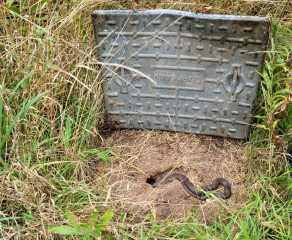
Large adult grass snake with it's head down a hole
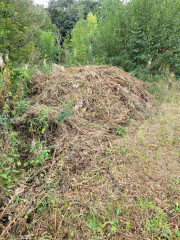
Habitat pile created by S-T Water ranger & his volunteers cutting back dense stands of Rosebay willowherb and stacking the arisings. These will be good for grass snakes.
Results of our 2022 Peak District & north Derbyshire pond surveys
Thank you to the members who helped with
these surveys this spring. 16 members helped
out on one or more surveys and in total 67 ponds
were surveyed, mostly by torchlight, 4 by bottle
trapping and at 2 water samples were taken for
testing for great crested newts by environmental
DNA as part of the Freshwater Habitats Trust’s
PondNet survey now in its 8th year. The results
from the eDNA are not yet available but for the
other 65 ponds great crested newts were found
in 36 ponds.
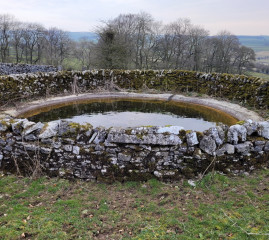
Walled concrete dewpond, torch light survey showed great crested and smooth newts present
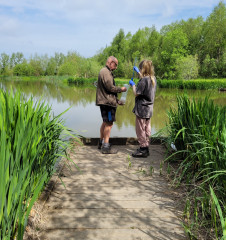
Water sampling for Freshwater Habitats Trust's PondNet GCN eDNA project
Events
Events
Past Events
Show Upcoming EventsNatterjack Toads talk and Derbyshire ARG AGM
Sat 2nd March, 2019 - Sat 2nd March, 2019
Derbyshire ARG AGM & Spring meeting from 2.30 to 4.30pm
2.30 pm Talk by Dr Graham Rowe, Senior Lecturer in Environmental Sciences at Derby University about Natterjack Toads in the British Isles, their conservation and what we can learn from their genetic patterns. Graham spent a decade working on Natterjack Toad research at the University of Sussex with Prof. Trevor Beebee.
Followed by the Derbyshire ARG AGM at 4.00pm
Venue: Derbyshire Wildlife Trust HQ, Sandy Hill, Main Street, Middleton by Wirksworth, DE4 4LR
Free parking at venue
| 2.00 pm |
A Natter About Natterjacks: Ice Age Genetics Patterns and the Conservation of the Natterjack Toad in Britain. Presentation by Dr Graham Rowe, Senior Lecturer in Molecular Ecology at Derby University --------------------------------------------------------------------------------- |
| 3.25 pm | Tea / coffee break |
-----------------------------------------------------------------------------------------
3.40 pm Group Annual General Meeting
- Apologies for absence
- Matters arising from the minutes of the 2018 AGM
- Chair’s Report
- Membership subscription - the committee proposes that a membership subscription fee of £5.00 is introduced in 2019
- Treasurer ‘s Report
- Election of Group Officers
Chair, Vice Chair, Secretary and Treasurer
7. Election of committee members
There are currently vacancies for 2 further committee members
- Any other formal business
| 4.00 pm |
County Toads Crossing Co-ordinator Role Kelvin Lawrence Including preparation for the Toads on Roads 2019 season, updated guidance and renewal of volunteer insurance forms for toad crossing volunteers. |
4.30 pm Close
Toad crossings
Mon 4th March, 2019 - Mon 1st April, 2019
Depending on weather conditions across the county we will be running our volunteer toad crossing patrols at various sites across the county from Overseal in the south to Furness Vale in the north. These may start & finish earlier if weather is mild and damp.
If you would like to volunteer please contact our County Toad Crossing Co-Ordinator Kelvin Lawrence at derbyshirearg.toads@gmail.com
Adder field survey meeting
Sat 23rd March, 2019 - Sat 23rd March, 2019
Members only event
Details & location to be confirmed
GCN Survey training course
Sat 4th May, 2019 - Sun 5th May, 2019
Great Crested Newts and Licensing for Surveys training course.
Saturday 4th May and Sunday 5th May 2019
Hilton, South Derbyshire
A one day training course and field survey session on the Saturday followed by shorter field survey session on the Sunday morning.
This will cover Species ID, Ecology, Legal status and Licensing, Great crested newt survey methods including environmental DNA (eDNA), the GCN Habitat Suitability Index (HSI) and Biosecurity, followed by field sessions demonstating survey methods, including bottle trapping and torchlight surveys.
This course is open to non-members at a cost of £30 Opportuntities after the course to gain further experience by taking part in Derbyshire ARG GCN survey trips in the Peak District National Park and adjacent areas.
UPDATE 26 APRIL: THIS COURSE IS NOW FULLY BOOKED UP
Course details ![]() GCN_Training_Course_details_2019.pdf
GCN_Training_Course_details_2019.pdf
Torchlight amphibian surveys
Tue 7th May, 2019 - Sat 1st June, 2019
The survey on 14th May is now fully booked but we will be surveying other sites in May, particularly monitoring great crested newt colonisation of newly restored dewponds in the Peak District National Park and monitoring some nature reserve ponds in Derbyshire. If you are interested in joining a survey please contact is on derbyshirearg@gmail.com
Newt survey
Sat 11th May, 2019 - Sun 12th May, 2019
To install bottle traps for a newt survey at a site near Hartington in the Peak District National Park.
Start time on Saturday 17.00 duration approximately 2 hours, followed up by visit to check and remove traps on Sunday morning at 9.30am
To book a place email us at derbyshirearg@gmail.com
PondNet GCN eDNA survey
Sat 18th May, 2019 - Sat 18th May, 2019
Field trip to undertake 5th year of eDNA sampling for Freshwater Habitats Trust's PondNet Project at the Pilsbury site near Hartington in the Peak District National Park. So far we have had two years with positive and two years with negative eDNA results for great crested newt presence in the pond. Also to complete the Pond Habitat survey recording form on site
Start time 9.30am, duration approximately 2 hours (its a long walk to the pond from the nearest farm!)
To book a place email us at derbyshirearg@gmail.com
Hardwick Hall Bioblitz
Sat 29th June, 2019 - Sat 29th June, 2019
We will be at the National Trust's Bioblitz on their Hardwick Hall estate between 10am and 4pm.
Apart from our information display on native amphibians and reptiles which will be in the Stableyard you can join us as we carry out a reptile survey at various locations within the estate to see what species we can find.
Derbyshire Countryside Service's Woodland Festival at Elvaston Castle Country Park
Sat 21st September, 2019 - Sun 22nd September, 2019
We will be at this popular annual event again this year with our information display on native amphibians and reptiles, together with childrens activities and asking adults for any herpetological sightings.
DANES Annual Show
Sat 9th November, 2019 - Sat 9th November, 2019
We will be having a stand at the annual Derbyshire and Nottinghamshire Entomological Society's Exhibition / Insect Show at Nottingham Trent University, Brackenhurst Campus, Southwell, Notts, NG25 0QF. The campus is located on the A612 Nottingham Road. Onsite refreshments will be available. Full details to follow.
Photo gallery
Photo Gallery
Contact us
Contact Us
DerbysARG
Matlock
Derbyshire
DE4 4NF
For Toad Crossings and to contact our Derbyshire Toad Crossings Co-ordinator please email derbyshirearg.toads@gmail.com
Upcoming Events
- Reptile Surveys
12th Apr, 2024 - 5th Oct, 2024 - DaNES autumn show
9th Nov, 2024 - 9th Nov, 2024 - National Forest pond walk
13th Apr, 2025 - 13th Apr, 2025
Latest News
- Rewilding success at British Mountaineering Council owned Horseshoe Quarry
15/06/2024 3:37 pm - 2023 Surveys and Events
22/09/2023 5:00 pm - Nature and Species Recovery in Derbyshire
12/02/2023 5:01 pm - Linacre reservoirs reptile survey
16/09/2022 8:05 pm - Results of our 2022 Peak District & north Derbyshire pond surveys
16/09/2022 7:49 pm
© Derbyshire Amphibian and Reptile Group
Website hits: 34585
View All | Find out how to get a mini-website for your ARG
© ARG UK Local Groups mini-websites 2024
Wind powered websites by Aye-aye Design.
